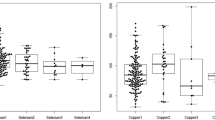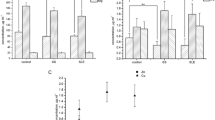Abstract
The status of essential and toxic trace metals in the blood of Crohn’s disease (CD) patients is unexplained. This study aimed to provide the first elemental profiling of the most recognized essential elements (Mn, Cu, Zn, Se) and selected toxic trace elements (As, Cd, Pb, and U) in sera and cell lysate (CL) samples of CD patients (n = 84). The results were compared with sex- and age-matched samples from the control group (CG). CD sera contained significantly higher levels of Mn, As, Cd, Pb, and U than did CG sera. An identical pattern, with the added inclusion of Cu (also higher in CD patients than in the CG), was obtained for CL samples. However, the most important finding was hypermanganesemia, which indicates that Mn could act as a toxic trace metal in CD. As, Cd, and U were the most significant toxic elements that showed antagonistic effects on the extrusion of essential Mn and Cu. Circulatory system screening markers for CD are hereby proposed (Mn/Cu, Mn/As, and Mn/Pb ratios). These three metal ratios were strongly and significantly correlated with F-Calprotectin levels, and deserve consideration as new markers of CD. The target metals and metal ratios should be taken into consideration as novel initiating and/or modifying factors for CD.

Similar content being viewed by others
Data Availability
Data and material are available from the corresponding author on reasonable request.
Code Availability
Not applicable.
References
Stochel-Gaudyn A, Fyderek K, Kościelniak P (2009) Serum trace elements profile in the pediatric inflammatory bowel disease progress evaluation. J Trace Elem Med Biol 55:121–126
van der Sloot KWJ, Weersma RK, Dijkstra G, Alizadeh BZ (2019) Development and validation of a web-based questionnaire to identify environmental risk factors for inflammatory bowel disease: the Groningen IBD Environmental Questionnaire (GIEQ). J Gastroenterol 54:238–248
Burisch J, Jess T, Martinato M, Lakatos PL (2013) ECCO -EpiCom, The burden of inflammatory bowel disease in Europe. J Crohns Colitis 7:322–337
Ananthakrishnan AN (2015) Epidemiology and risk factors for IBD. Nat Rev Gastroenterol Hepatol 12:205–217
Kikut J, Konecka N, Ziętek M, Szczuko M (2018) Inflammatory bowel disease etiology: current knowledge. Pteridines 29:206–214
Torres J, Mehandru S, Colombel JF, Peyrin-Biroulet L (2017) Crohn’s disease. Lancet 389:1741–1755
Baumgart DC, Sandborn WJ (2012) Chron’s disease. Lancet 380:1590–1605
Su HJ, Chiu YT, Chiu CT, Lin YC, Wang CY, Hsieh JY, Wei SC (2019) Inflammatory bowel disease and its treatment in 2018: global and Taiwanese status updates. J Formos Med Assoc 118:1083–1092
Legaki E, Gazouli M (2016) Influence of environmental factors in the development of inflammatory bowel diseases. World J Gastrointest Pharmacol Ther 7:112–125
Sanchis-Artero L, Martínez-Blanch JF, Manresa-Vera S, Cortés-Castell E, Rodriguez-Morales J, Cortés-Rizo X (2020) Evaluation of changes in gut microbiota in patients with Crohn’s disease after anti-tnfα treatment: prospective multicenter observational study. Int J Environ Res Public Health 17:5120
Dam AN, Berg AM, Farraye FA (2013) Environmental influences on the onset and clinical course of Crohn’s disease-part 1: an overview of external risk factors. Gastroenterol Hepatol (N Y) 9:711–717
Miele E, Shamir R, Aloi M, Assa A, Braegger C, Bronsky J, de Ridder L, Escher JC, Hojsak I, Kolaček S, Koletzko S, Levine A, Lionetti P, Martinelli M, Ruemmele F, Russell RK, Boneh RS, van Limbergen J, Veereman G, Staiano A (2018) Nutrition in pediatric inflammatory bowel disease: a position paper on behalf of the Porto inflammatory bowel disease group of the European Society of Pediatric Gastroenterology, Hepatology and Nutrition. J Pediatr Gastroenterol Nutr 66:687–708
Ripoli J, Miszputen SJ, Ambrogini O Jr, de Carvalho L (2010) Nutritional follow-up of patients with ulcerative colitis during periods of intestinal inflammatory activity and remission. Arq Gastroenterol 47:49–55
Rice KM, Walker EM Jr, Wu M, Gillette C, Blough ER (2014) Environmental mercury and its toxic effects. J Prev Med Public Health 47:74–83
Lichtenstein GR, Loftus EV, Isaacs KL, Regueiro MD, Gerson LB, Sands BE (2018) ACG clinical guideline: management of Crohn’s disease in adults. Am J Gastroenterol 113:481–517
Stojsavljević A, Lj V, Rovčanin B, Borković-Mitić S, Gavrović-Jankulović M, Manojlović D (2020) Assessment of trace metal alterations in the blood, cerebrospinal fluid and tissue samples of patients with malignant brain tumors. Sci Rep 10:3816
O’Toole A, Korzenik J (2014) Environmental triggers for IBD. Curr Gastroenterol Rep 16:396
Leso V, Ricciardi W, Iavicoli I (2015) Occupational risk factors in inflammatory bowel disease. Eur Rev Med Pharmacol Sci 19:2838–2851
Gîlcă-Blanariu GE, Diaconescu S, Ciocoiu M, Ștefănescu G (2018) New insights into the role of trace elements in IBD. Biomed Res Int 2018:1813047
Marin-Valencia I (2015) Disorders of manganese transport. In: Rosenberg’s molecular and genetic basis of neurological and psychiatric diseases, 5th edn, Chapter 44. Academic Press, pp 483–493
Kresovich JK, Bulka CM, Joyce BT, Vokonas PS, Schwartz J, Baccarelli AA, Hibler EA, Hou L (2018) The inflammatory potential of dietary manganese in a cohort of elderly men. Biol Trace Elem Res 183:49–57
Balsano C, Porcu C, Sideri S (2018) Is copper a new target to counteract the progression of chronic diseases? Metallomics 10:1712–1722
Engwa GA, Ferdinand PU, Nwalo FN, Unachukwu MN (2019) Mechanism and health effects of heavy metal toxicity in humans. Poisoning in the modern world - new tricks for an old dog? Ozgur Karcioglu and Banu Arslan, IntechOpen. https://doi.org/10.5772/intechopen.82511. Available from: https://www.intechopen.com/chapters/64762
Breton J, Massart S, Vandamme P, De Brandt E, Pot B, Foligné B (2013) Ecotoxicology inside the gut: impact of heavy metals on the mouse microbiome. BMC Pharmacol Toxicol 11:62
Mishima Y, Sartor RB (2020) Manipulating resident microbiota to enhance regulatory immune function to treat inflammatory bowel diseases. J Gastroenterol 55:4–14
Nair N, Austin C, Curtin P, Gouveia C, Arora M, Torres J (2020) Mount Sinai Road to Prevention Group, Association between early-life exposures and inflammatory bowel diseases, based on analyses of deciduous teeth. Gastroenterology 159:383–385
Freeman HJ (2008) Colorectal cancer risk in Crohn’s disease. World J Gastroenterol 14:1810–1811
Mahid SS, Minor KS, Soto RE, Hornung CA, Galandiuk S (2006) Smoking and inflammatory bowel disease: a meta-analysis. Mayo Clin Proc 81:1462–1471
Ha F, Khalil H (2015) Crohn’s disease: a clinical update. Therap Adv Gastroenterol 8:352–359
Uchiyama K, Haruyama Y, Shiraishi H, Katahira K, Abukawa D, Ishige T, Tajiri H, Uchida K, Uchiyama K, Washio M, Kobashi E, Maekawa A, Okamoto K, Sairenchi T, Imamura Y, Ohhira S, Hata A, Kobashi G (2020) Association between passive smoking from the mother and pediatric Crohn’s disease: a Japanese multicenter study. Int J Environ Res Public Health 17:2926
Juloski JT, Rakic A, Ćuk VV, Ćuk VM, Stefanović S, Nikolić D, Janković S, Trbovich AM, De Luka SR (2020) Colorectal cancer and trace elements alteration. J Trace Elem Med Biol 59:126451
Sikora M, Baranowska-Bosiacka I, Rębacz-Maron E, Olszowski T, Chlubek D (2019) The influence of the place of residence, smoking and alcohol consumption on bone mineral content in the facial skeleton. J Trace Elem Med Biol 51:115–122
Funding
This research was financially supported by the Ministry of Education, Science and Technological Development of the Republic of Serbia, Contract Number: 451–03-9/2021–14/200288.
Author information
Authors and Affiliations
Contributions
A.S. designed the investigation, conducted the experimental study, analyzed the data, and wrote the first and last version of the paper; A.S.M. and Lj.T. collected clinical specimens; A.S.M., B.R. and D.M. participated in writing through reviewing and editing. All authors contributed critically to the draft and gave final approval for publication.
Corresponding author
Ethics declarations
Ethics Approval
Approval was obtained by the Local Ethical Board of the Clinic for Gastroenterology, Clinical Center of Serbia (Belgrade).
Consent to Participate
All patients and healthy blood donors voluntarily participated in this study, and written informed consent from all study participants was obtained according to the ethical standards defined by the Declaration of Helsinki.
Consent for Publication
Not applicable.
Conflict of Interest
The authors declare no competing interests.
Additional information
Publisher's Note
Springer Nature remains neutral with regard to jurisdictional claims in published maps and institutional affiliations.
Supplementary Information
Below is the link to the electronic supplementary material.
Rights and permissions
About this article
Cite this article
Stojsavljević, A., Sokić-Milutinović, A., Rovčanin, B. et al. Profiling of Circulatory Elements Reveals Alteration of Essential and Toxic Trace Metals in Crohn’s Disease . Biol Trace Elem Res 200, 2572–2580 (2022). https://doi.org/10.1007/s12011-021-02862-4
Received:
Accepted:
Published:
Issue Date:
DOI: https://doi.org/10.1007/s12011-021-02862-4




